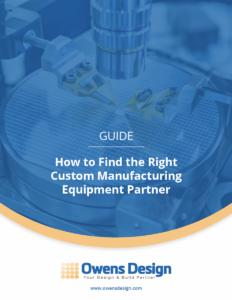Unveiling Deeper Needs: Putting Customers First in the Custom Equipment Design & Build Process

By Lori Runyan
VP of Program Management
In the fast-paced business world, it’s easy to prioritize streamlined processes and criteria fit, while inadvertently shortchanging customer-centricity. As a leader in the engineering sector, I have witnessed how the relentless pursuit of technical excellence can overshadow the deeper needs of our customers.
In this article, I want to share my perspective on the importance of understanding customer needs right from the start. By embracing a holistic approach and redirecting our focus towards the customer’s underlying needs, we can build stronger relationships, deliver exceptional experiences, and drive mutual success.
Exploring Strategic Objectives: The Foundation of Understanding
Guiding our teams beyond superficial interactions and toward a more strategic understanding of our customers is our duty as leaders. Instead of over focusing on technical specifications, we should inspire our teams to learn what is genuinely important to our customers. This can be accomplished with strategic queries such as, “What are your primary strategic objectives?” or “What outcomes are you aiming to realize through this partnership?” Such questions can help reveal a wider vision of the customer’s needs, beyond our own area of expertise.
Some typical strategic objectives for our customers include:
- Commercialization or “fab readiness” of a product
- Faster time-to-market
- Volume ramp
Sometimes, strategic objectives are broader and include environmental, user or corporate goals. The better we understand their high-level objectives, the better we can position ourselves as partners invested in the long-term success of our customers.
Addressing Concerns and Fears: Empathy as the Key
As leaders, nurturing an atmosphere of empathy within our institutions is crucial. We must prioritize the concerns and fears of our customers with sincerity and understanding. By asking about their worries, we gain a comprehensive view of their expectations, building trust, and opening the door for tailored solutions.
Questions such as, “What are your biggest concerns or fears regarding the program?” or “What potential obstacles do you anticipate?” spark dialogue, foster trust, and pave the way for more tailored solutions.
Tailoring Solutions to Customer Needs: Customization as a Competitive Advantage
In our pursuit of technical excellence, we must always remember that the true value lies in tailoring our solutions to meet the unique needs of our customers. As leaders, we must encourage our teams to consider factors beyond technical specifications, such as schedule, budget constraints, and criticality. By doing so, we can propose solutions that align with their specific circumstances, providing them with a competitive advantage.
To underscore the power of addressing concerns and tailoring solutions, let me share an example from our work with a client in the semiconductor industry.
During our discussions, the client stakeholders expressed concerns about project timelines and potential delays – which they’d experienced with other vendors. Commitments had been made to their end-customer, and on-time delivery was critical to the success of the program and the company. We engaged in an open and honest dialogue, listening closely to their worries and discussing options and tradeoffs.
By understanding their fears, we were able to develop an engineering approach with a detailed project plan that met their timeline AND accounted for potential challenges and risks. This level of proactive engagement not only addressed their specific concerns but also solidified our partnership as a trusted advisor invested in their success.
Cultivating a Customer-Centric Culture
It is our responsibility to cultivate a customer-centric culture within our organizations. By developing a deep understanding and empathy for the customer’s needs, our teams can genuinely grasp how best to assist them. Through strategic questioning, addressing concerns, and tailoring solutions to program needs, we position ourselves as trusted advisors rather than mere salespeople or engineers.
In the rush to close a deal or hit a deadline, opportunities for active listening are often overlooked. By embracing a holistic approach beyond technical expertise, we can uncover the deeper needs of our customers and foster stronger relationships.
Contact us to learn more about custom equipment design and build
